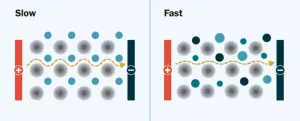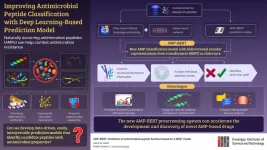(Press-News.org) Irvine, Calif., Feb. 23, 2023 – People often associate Escherichia coli with contaminated food, but E. coli has long been a workhorse in biotechnology. Scientists at the University of California, Irvine have demonstrated that the bacterium has further value as part of a system to detect heavy metal contamination in water.
E. coli exhibit a biochemical response in the presence of metal ions, a slight change that researchers were able to observe with chemically assembled gold nanoparticle optical sensors. Through a machine-learning analysis of the optical spectra of metabolites released in response to chromium and arsenic exposure, the scientists were able to detect metals in concentrations a billion times lower than those leading to cell death – while being able to deduce the heavy metal type and amount with higher than 96 percent accuracy.
The process, which the researchers said can be accomplished in about 10 minutes, is the subject of a study appearing in Proceedings of the National Academy of Sciences.
“This new water monitoring method developed by UCI researchers is highly sensitive, fast and versatile,” said co-author Regina Ragan, UCI professor of materials science and engineering. “It can be broadly deployed to monitor toxins at their sources in drinking and irrigation water and in agricultural and industrial runoff. This system can provide an early warning of heavy metal contamination to safeguard human health and ecosystems.”
In addition to proving that bacteria like E. coli can detect unsafe water, the researchers spotlighted the other necessary components – gold nanoparticles assembled with molecular precision and machine learning algorithms – which greatly enhanced the sensitivity of their monitoring system. Ragan said it can be applied toward spotting metal toxins – including arsenic, cadmium, chromium, copper, lead and mercury – at levels orders of magnitude below regulatory limits to provide early warning of contamination.
In the study, the scientists explained that they can apply trained algorithms to unseen tap water and wastewater samples, which means the system can be generalized to water sources and supplies anywhere in the world.
“This transfer learning method allowed the algorithms to determine if drinking water was within U.S. Environmental Protection Agency and World Health Organization recommend limits for each contaminant with greater than 96-percent accuracy and with 92-percent accuracy for treated wastewater,” Ragan said.
“Access to safe water is necessary for the health of people and the planet,” she added. “New technology that can be mass manufactured at low-cost is needed to monitor the introduction of an array of contaminants in the water supply as a critical part of the solution for water security in the face of pollution and climate change.”
Joining Ragan on this project, which was funded by the National Science Foundation, were Hong Wei and Yixin Huang, UCI graduate student researchers in materials science and engineering; Yen-Hsiang Huang, UCI graduate student researcher in civil and environmental engineering; Sunny Jiang, UCI professor of civil and Environmental engineering; and Allon Hochbaum, UCI professor of materials science and engineering.
About the University of California, Irvine: Founded in 1965, UCI is a member of the prestigious Association of American Universities and is ranked among the nation’s top 10 public universities by U.S. News & World Report. The campus has produced five Nobel laureates and is known for its academic achievement, premier research, innovation and anteater mascot. Led by Chancellor Howard Gillman, UCI has more than 36,000 students and offers 224 degree programs. It’s located in one of the world’s safest and most economically vibrant communities and is Orange County’s second-largest employer, contributing $7 billion annually to the local economy and $8 billion statewide. For more on UCI, visit www.uci.edu.
Media access: Radio programs/stations may, for a fee, use an on-campus ISDN line to interview UCI faculty and experts, subject to availability and university approval. For more UCI news, visit news.uci.edu. Additional resources for journalists may be found at communications.uci.edu/for-journalists.
END
UC Irvine researchers create E. coli-based water monitoring technology
Bacterium used as a live sensor to detect heavy metal contamination
2023-02-23
ELSE PRESS RELEASES FROM THIS DATE:
New $2.9 million grant helps researchers address food insecurity for Hoosiers
2023-02-23
INDIANAPOLIS—With a $2.9 million grant from the National Institute on Minority Health and Health Disparities, researchers from Indiana University School of Medicine are working to improve food insecurity in Indiana and ultimately improve the health of people in Indiana.
Individuals who experience food insecurity–inconsistent access to affordable and nutritious food–are more susceptible to a variety of health conditions, including hypertension and Type 2 Diabetes. The FoRKS: Food Resources ...
On the road to better solid-state batteries
2023-02-23
A team from Lawrence Berkeley National Laboratory (Berkeley Lab) and Florida State University has designed a new blueprint for solid-state batteries that are less dependent on specific chemical elements, particularly critical metals that are challenging to source due to supply chain issues. Their work, reported recently in the journal Science, could advance solid-state batteries that are efficient and affordable.
Touted for their high energy density and superior safety, solid-state batteries could be a game-changer for the electric car industry. ...
National Center to Reframe Aging welcomes 16 to new advisory board
2023-02-23
The National Center to Reframe Aging — the nation’s leading organization dedicated to reshaping the conversation about older people — has established a new advisory board with 16 members from such diverse professional backgrounds as communications and public relations, research, policy, and law.
These board members were tapped to bring knowledge, strategic thinking, and interpersonal attributes to their role; to identify key organizations and decision-makers who can help advance the initiative; and support activities aligning with National Center project goals.
“We look forward to working with this talented group of advisors to grow ...
Heterostructures developed at Purdue support predictions of counterpropagating charged edge modes at the v=2/3 fractional quantum Hall state
2023-02-23
In 2018, a team of physicists at Purdue University invented a device which experimentally showed quasiparticles interfering for the first time in the fractional quantum Hall effect at filling factor v=1/3. Further development of these heterostructures has allowed the Manfra Group to expand their research to experiments that explore counterflowing charged edge modes at the 2/3 fractional quantum Hall state.
They have recently published their findings, “Half-Integer Conductance Plateau at the ν = 2/3 Fractional Quantum Hall State in a Quantum Point Contact,” in Physical Review Letters on February 17, 2023. This ...
Fungi that causes pine ghost canker detected in southern California trees
2023-02-23
Fungal pathogens that cause die-back in grape, avocado, citrus, nut and other crops has found a new host and is infecting conifer trees causing Pine Ghost Canker in urban forest areas of Southern California.
The canker can be deadly to trees.
Scientists from University of California, Davis, first spotted evidence that the pathogens had moved to pines during a routine examination of trees in Orange County in 2018. Over four years, they found that more than 30 mature pines had been infected in an area of nearly 100 acres, according ...
GIST researchers develop “AMP-BERT”: A new AI-based “finder” of antimicrobial peptides
2023-02-23
Over the last few decades, antimicrobial resistance has become a major public health concern globally. This has led to a search for alternative methods of treating microbial infections. One such innovation is the discovery of antimicrobial properties of certain peptides. Antimicrobial peptides (AMPs) are short peptides found in most animals, plants, and microorganisms as a natural defense against infections. AMPs combat harmful bacteria via a nonspecific mechanism that prevents them from developing antimicrobial resistance. Despite these exceptional abilities, research on AMPs is being hindered because the existing systems for identifying candidate ...
Alternate framework for distributed computing tames Big Data’s ever growing costs
2023-02-23
The sheer volume of ‘Big Data’ produced today by various sectors is beginning to overwhelm even the extremely efficient computational techniques developed to sift through all that information. But a new computational framework based on random sampling looks set to finally tame Big Data’s ever-growing communication, memory and energy costs into something more manageable.
A paper describing the framework was published in the journal Big Data Mining and Analytics on Jan. 26.
The amount of data being produced from social networks, business transactions, the ‘Internet of Things’, finance, healthcare and beyond has exploded ...
Insilico Medicine sends first generative AI-designed drug for COVID-19 and variants to clinic
2023-02-23
Insilico Medicine, a clinical-stage biotech company powered by generative AI, today announces that China National Medical Products Administration (NMPA) has approved the Investigational New Drug (IND) application for ISM3312, an orally available 3CLpro inhibitor generated and designed with the support of Insilico’s proprietary generative chemistry platform Chemistry42 for the treatment of COVID-19.
ISM3312 is a highly selective small molecule inhibitor with a novel molecular structure optimized from compounds which were generated and designed by Chemistry42 based on the structure of 3CL protease. It binds to ...
Children’s lung capacity improved in cleaner air
2023-02-23
As air pollution in Stockholm has decreased, so has the lung capacity of children and adolescents has improved, a new study published in the European Respiratory Journal reports. The researchers from Karolinska Institutet consider the results important, since the lung health of the young greatly affects the risk of their developing chronic lung diseases later in life.
“Fortunately, we’ve seen a decrease in air pollutants and therefore an increase in air quality in Stockholm over the past 20 years,” says the study’s last author ...
CityU develops wireless, soft e-skin for interactive touch communication in the virtual world
2023-02-23
Sensing a hug from each other via the internet may be a possibility in the near future. A research team led by City University of Hong Kong (CityU) recently developed a wireless, soft e-skin that can both detect and deliver the sense of touch, and form a touch network allowing one-to-multiuser interaction. It offers great potential for enhancing the immersion of distance touch communication.
“With the rapid development of virtual and augmented reality (VR and AR), our visual and auditory senses are not sufficient for us to create an ...
LAST 30 PRESS RELEASES:
Making lighter work of calculating fluid and heat flow
Normalizing blood sugar can halve heart attack risk
Lowering blood sugar cuts heart attack risk in people with prediabetes
Study links genetic variants to risk of blinding eye disease in premature infants
Non-opioid ‘pain sponge’ therapy halts cartilage degeneration and relieves chronic pain
AI can pick up cultural values by mimicking how kids learn
China’s ecological redlines offer fast track to 30 x 30 global conservation goal
Invisible indoor threats: emerging household contaminants and their growing risks to human health
Adding antibody treatment to chemo boosts outcomes for children with rare cancer
Germline pathogenic variants among women without a history of breast cancer
Tanning beds triple melanoma risk, potentially causing broad DNA damage
Unique bond identified as key to viral infection speed
Indoor tanning makes youthful skin much older on a genetic level
Mouse model sheds new light on the causes and potential solutions to human GI problems linked to muscular dystrophy
The Journal of Nuclear Medicine ahead-of-print tip sheet: December 12, 2025
Smarter tools for peering into the microscopic world
Applications open for funding to conduct research in the Kinsey Institute archives
Global measure underestimates the severity of food insecurity
Child survivors of critical illness are missing out on timely follow up care
Risk-based vs annual breast cancer screening / the WISDOM randomized clinical trial
University of Toronto launches Electric Vehicle Innovation Ontario to accelerate advanced EV technologies and build Canada’s innovation advantage
Early relapse predicts poor outcomes in aggressive blood cancer
American College of Lifestyle Medicine applauds two CMS models aligned with lifestyle medicine practice and reimbursement
Clinical trial finds cannabis use not a barrier to quitting nicotine vaping
Supplemental nutrition assistance program policies and food insecurity
Switching immune cells to “night mode” could limit damage after a heart attack, study suggests
URI-based Global RIghts Project report spotlights continued troubling trends in worldwide inhumane treatment
Neutrophils are less aggressive at night, explaining why nighttime heart attacks cause less damage than daytime events
Menopausal hormone therapy may not pose breast cancer risk for women with BRCA mutations
Mobile health tool may improve quality of life for adolescent and young adult breast cancer survivors
[Press-News.org] UC Irvine researchers create E. coli-based water monitoring technologyBacterium used as a live sensor to detect heavy metal contamination






